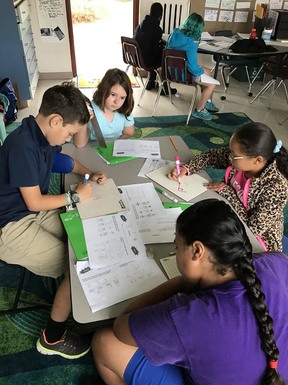Powerful Relationships
|
At the center of learning is the child, the family, and the teacher. To be a successful educator, we must commit ourselves to build powerful relationships, not only with students, but also with their families and the teams of educators we work with. I strive to uphold this in every decision I make as a professional.
"What [Mr. Grahl] did for [his students] was engage them, respect them and hold them to high standards. He has reached out to and connected with them as individuals... [My son] is learning how to give and earn respect. He’s learning how to work as part of a community. I feel very confident that Mr. Grahl is invested in helping bring out all the greatness that my child has inside of him."
-Dr. Julie Jones Parent of three at Cahoon Elementary Magnet School |
Differentiated Instruction and Choice

Content and process learning happens exactly where the child is at. Through discussion and formative assessment, I am able to locate each child's individual strengths, interests, and areas of need. Based on this data, I use careful grouping strategies and planning to differentiate my instruction.
For example, as my students embarked on their STEM Fair projects, I knew that this would require prolonged student interest and lean heavily on research skills and knowledge of the scientific method. I surveyed students on topics of interest. Honoring student responses and students' reading strengths, I organized small research groups.
I adapted research texts to students' reading levels and collected books and visual texts for each group to read focusing on their topic. Having a variety of texts that were accessible to all students reduced the cognitive load of reading, increased comprehension, and allowed all students to have access to the content and participate meaningfully in the research process goal.
For example, as my students embarked on their STEM Fair projects, I knew that this would require prolonged student interest and lean heavily on research skills and knowledge of the scientific method. I surveyed students on topics of interest. Honoring student responses and students' reading strengths, I organized small research groups.
I adapted research texts to students' reading levels and collected books and visual texts for each group to read focusing on their topic. Having a variety of texts that were accessible to all students reduced the cognitive load of reading, increased comprehension, and allowed all students to have access to the content and participate meaningfully in the research process goal.
A Culture of Academic Discussion
|
Students learn through multi-modal communication of and about ideas. Teaching students how to communicate thoughts and evaluate positions provides students with agency in the classroom and centers learning around peer-to-peer interactions.
Increasing the depth and frequency of academic peer-to-peer discussions has been a central goal in my teaching this year. Explicit interactive modeling and discussion stems immersed my students in the genre of academic discussion. This scaffolding allowed all students to use and understand accountable talk across subjects. By establishing a culture of academic discussion in which all participants consistently held one another accountable dramatically increased the frequency of rich discussions in my classroom. |
"Mr. Grahl uses a variety or series of questions and prompts to challenge students cognitively, advance high level thinking and discourse, and promote meta-cognition. The students formulate many questions, initiate topics and make unsolicited contributions. The students themselves ensure that all voices are heard in the discussion."
-Joanne Griffiths
Principal at Cahoon Elementary Magnet School of Animal Science
-Joanne Griffiths
Principal at Cahoon Elementary Magnet School of Animal Science
Vocabulary Rich Environment
|
Vocabulary rich environments level the playing field for students of all knowledge backgrounds. Consistently engaging students in learning opportunities that focus on developing and using new vocabulary increases all students' access to not only content but the world around them.
For example, a routine in my science classroom is 5 day vocabulary. Each week we focus on 3-4 essential words that are relevant to the content. At the beginning of daily science instruction, students create Frayer Models, draw pictures, invent hand gestures, use the words in authentic writing contexts, and even mold clay to represent the words. |





